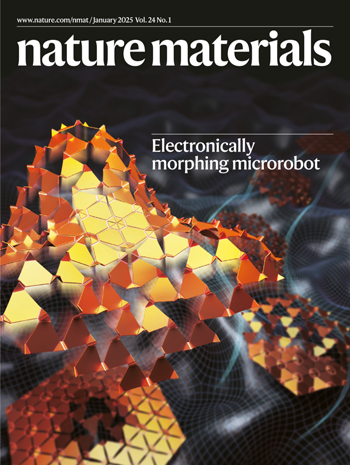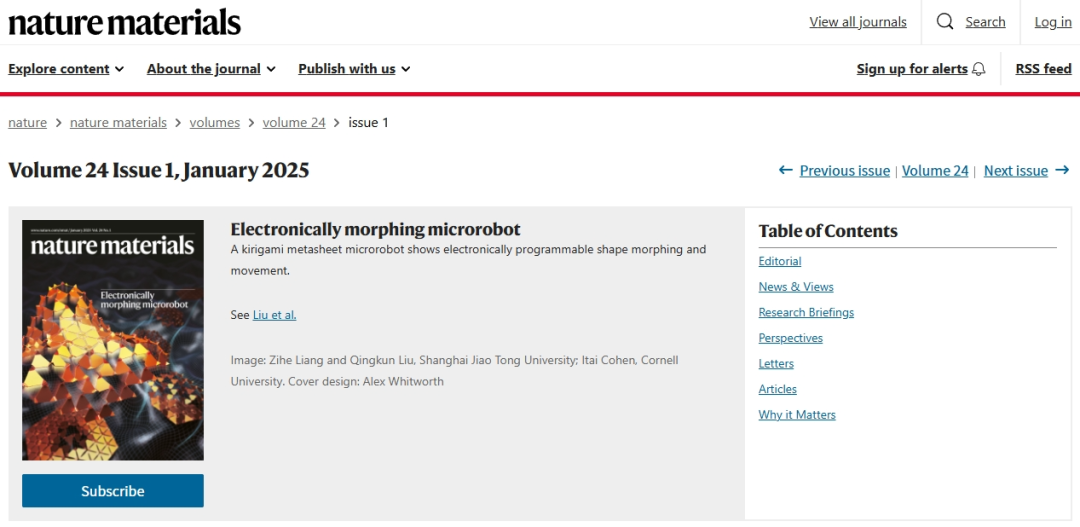
第24巻第1号、2025年1月
Qingkun Liu、Wei Wang、Himani Sinhmar、Itay Griniasty、Jason Z. Kim、Jacob T. Pelster、Paragkumar Chaudhari、Michael F. Reynolds、Michael C. Cao、David A. Muller、Alyssa B. Apsel、Nicholas L. Abbott、Hadas Kres-Gazit、Paul L. McEuen & Itai Cohen
この号の表紙は 自然素材 は "電子的に構成可能な微小メタシートロボット発行者 イタイ・コーエン教授 コーネル大学と 劉青坤准教授 上海交通大学の教授。

研究背景
微生物学の分野では、微小生物の移動には形状変化が不可欠です。しかし、サブミリメートルサイズのロボットでこの形状変化を実現することは、常に技術的な課題でした。これは主に、サイズが小さくなるにつれて、小型化に伴う様々な障害(製造の難しさ、駆動機構の設計など)が特に顕著になるためです。したがって、マイクロスケールで形状変化を実現できるロボットの開発は、マイクロロボティクス技術の発展を促進する上で非常に重要な意義を持っています。
研究の意義
本研究では、小型化に伴う課題を克服し、微小な電子プログラム可能な変形可能なメタシートロボットの実現に成功した。このロボットは、10ナノメートルの電気化学的に駆動するヒンジから100マイクロメートルの展開パネルまで、5桁の切り紙構造を用いて局所的な拡張を実現した。これらのパネルは、40%の伸縮が可能なユニットセルに構成され、約1mmのロボットサイズの中に、200個以上のヒンジと独立した電子駆動領域を備えたメタサーフェスを形成する。この設計により、ロボットは独自の曲率分布を持つ異なるターゲット形状を切り替えることができる。また、独立した領域を電子的に駆動し、位相遅延を事前に設定することで、ロボットの歩行動作も実現した。
この研究成果は、微視的スケールでの形態変化の実現可能性を実証するだけでなく、微小で連続的、柔軟でプログラム可能なロボットの開発への新たな道を切り開きます。これはロボット工学分野における大きな進歩であるだけでなく、再構成可能なマイクロマシン、チューナブルな光メタサーフェス、マイクロバイオメディカルデバイスなど、幅広い応用分野への理論的基盤と技術的サポートを提供します。
研究の展望
この研究成果は、一連の革新的な応用開発を促進することが期待されます。再構成可能マイクロマシンの分野では、この微細形態変化技術を用いることで、環境変化や作業要件に応じて形状を自動調整できるマイクロマシンを製造できます。また、チューナブル光メタサーフェスの分野では、メタサーフェスの形態を動的に調整することで、光の精密操作を実現し、光通信、イメージング、センシングなどの分野に革命的な変化をもたらします。さらに、バイオメディカルの分野では、このマイクロプログラマブルロボットが精密医療、生体内薬物送達、マイクロサージェリーなどの最先端分野で活用され、医療の効率と精度を大幅に向上させることが期待されます。
カバーデザインのプロセス
営業時間
11/21 月曜日 - 11/23 水: 午前 9 時 - 午後 8 時
11/24木: 休業 - 感謝祭おめでとうございます!
11/25(金): 午前8時~午後10時
11/26 土 - 11/27 日: 午前 10 時 - 午後 9 時
(すべての時間は東部時間です)